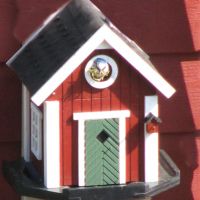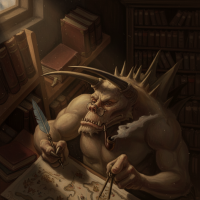A Monastery by the Sea
 Will Mason
🖼️ 97 images Traveler
Will Mason
🖼️ 97 images Traveler
I love doing maps that show levels in elevation, though it's challenging. I could have made the elevation levels blend together using shadows and edge fades, but not on this one. I like the feeling of hard shelves sometimes. I feel like an elaborate monastery like this one could be used anywhere, with symbols changed out to fit the new occupants. This particular monastery is dedicated to an insect deity (those are bee hives in the gardens). Any thoughts or suggestions are most welcome.










Comments
The elevation changes are really great!
What a great map! I love the hard elevation changes in this one.
It does look like the land is floating above (rather than sitting in) the water to me. But that may just be me…
It's not just you. It's the shadows.
Yeah, maybe the way the glow on the coast is between the land and the shadows? It looks like surf, but the shadows should fall over it as well. May not be possible to have both, and not have the floaty effect.
Its posable, look at the island. the shadow is on top of the surf. Yhe bridge shadow is above the surf as well. A sheet order problem?
Often, shadowing problems like this can be improved by softening the appearance of the shadows, to make them more subtle (increased transparency, reduced size, altered colouring, adjusted blurring are all possibilities).
The bridge shadow's showing an odd gap, and its presence illustrates that a shadow effect stacked on another one starts to look odd - the bridge is further from the sea than the cliff bases, yet its shadow is more distinct, for instance.
One option to escape that double-shadowing trap might be to use the existing shadow effect lines and areas to redraw the shadow as a separate polygon, and then turn off the shadow effects entirely. Using one of the "Solid" bitmap fills might work for this, or just a normal darker grey polygon with a suitable transparency effect.
There's also the possibility of adding some extra shadow effects to the little rocks in the sea, as they currently don't have any shadows, which makes them look a little odd where they're exposed to the light. If they're all only low-lying rocks though, they'd cast negligible shadows from this viewpoint anyway, so that may be a shadow effect too far 😉.
Thanks so much for the comments on shadows. I always have issues with overlapping shadows. With a lighted bevel on the cliffs, I have to put a base on it for it to work. I usually place a shadow on the base instead of the bevel sheet. The glow on the beach is probably coming from the base sheet. I think it's too bright. I think what I'll do is draw all the shadows by hand on its own sheet. I've done that before and it makes things look way more natural. As for the beach, I'll probably just create a beach sheet and place a real sandy shore there instead of the glow. You all are awsome for leaving comments! I appreciate it.
Here's the new one with the beach looking a little better. But there's another problem. I have the outer wall shadows of the monastery blending with the long outside wall shadow (under the wall), blending with the highest tier of the cliff shadow. That isn't right. If I remove the outer wall shadow (the short one on the wall itself), then I won't have any wall shadows inside the building either. The only way I can see to address that is to draw a shadow by hand and then split the outer wall into two sheets, one with a shadow one without and hope that this doesn't look like I have a split wall. I guess I could do some kind of a floor mask, but I don't like what that's going to do to the whole map. It's a conundrum.
Here is a really time intensive solution. It's only a solution if you want to spend the time doing it.
Add a new sheet called SHADOWS or somesuch logical name, then draw a black polygon that is the full extent of both of those shadows. Move the sheet in the list to a position where it is drawn below the floor level, then add a small blur effect and a transparency effect and turn off all the shadows you've just traced on the other sheets. The idea is to replace all the shadows from all the different sheets with one general shadow.
Sue's solution is similar to one of the ideas I mentioned earlier as regards compiling the multiple shadows into one general shadow, although it won't solve the problem of how you still retain the interior wall shadows from those outer walls (and there are further complications, because of the indented areas of the outer walls on the left side of the main building casting small triangular shadow patches in a couple of places).
It's a very tricky problem, as shadows can be in general, unfortunately. What I would note is that you don't need substantial lines/polygons to create substantial shadows. Even a zero-width line will cast a shadow just as strong as the walls do currently, if in the same position, for instance (although I try to avoid zero-width lines whenever possible, as they can create other problems sometimes; just give the lines a very, very small actual width instead). So you could maybe work that into a solution somehow.
Sue and Wyvern, you're absolutely right. On the maps where I've taken the time to use that technique, the shadows look much more natural. I'll make a sheet called "Shadows Outside" and usually put an edge fade (depends on the map but around 2 or 3) and a Blend Mode: Multiply (I usually use about 50 with the multiply and instead of using the color black I use the black/grey Solid 50 texture).